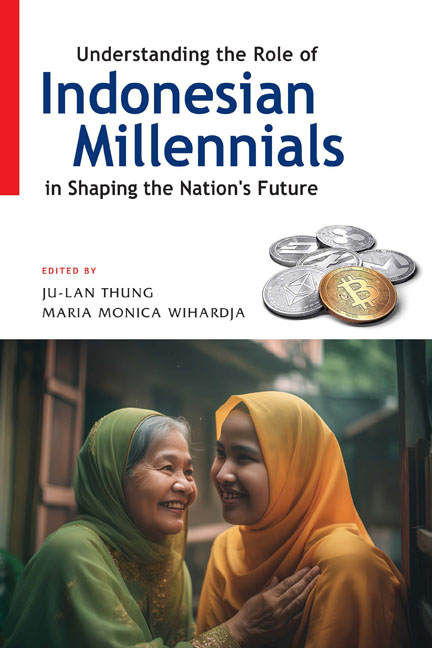Book contents
- Frontmatter
- Contents
- List of Figures
- List of Tables
- List of Annexes and Appendixes
- About the Contributors
- Introduction: Understanding the Role of Indonesian Millennials in Shaping a Nation’s Future
- 1 Generational Differences in Life Course Trajectories of Indonesians in Their Mid-twenties: Comparing Millennials and Older Cohorts
- 2 Millennials and Politics in Indonesia: 2019 and Beyond
- 3 Progressive Yet Powerless: The State of Indonesia’s Progressive Youth Organizations in the Post-Authoritarian Era
- 4 Indonesia’s Millennials and Gen Zs: Are They Financially (Il)literate?
- 5 Digital Competencies of the Millennial Generation in Micro, Small, and Medium Enterprises in West Bandung District
- 6 Millennial Muslims and “Haram Fatwas” on Cryptocurrency in Contemporary Indonesia
- 7 Youth and Religious Disaffiliation: A Study of Indonesian Millennials Learning Buddhism during Spiritual Disruption
- 8 Antagonism and Afterwards: Millennials in Indonesian Participatory Art after Reformasi
- 9 The NFT Phenomenon among Indonesia’s Millennial Artists
- Index
9 - The NFT Phenomenon among Indonesia’s Millennial Artists
Published online by Cambridge University Press: 13 April 2024
- Frontmatter
- Contents
- List of Figures
- List of Tables
- List of Annexes and Appendixes
- About the Contributors
- Introduction: Understanding the Role of Indonesian Millennials in Shaping a Nation’s Future
- 1 Generational Differences in Life Course Trajectories of Indonesians in Their Mid-twenties: Comparing Millennials and Older Cohorts
- 2 Millennials and Politics in Indonesia: 2019 and Beyond
- 3 Progressive Yet Powerless: The State of Indonesia’s Progressive Youth Organizations in the Post-Authoritarian Era
- 4 Indonesia’s Millennials and Gen Zs: Are They Financially (Il)literate?
- 5 Digital Competencies of the Millennial Generation in Micro, Small, and Medium Enterprises in West Bandung District
- 6 Millennial Muslims and “Haram Fatwas” on Cryptocurrency in Contemporary Indonesia
- 7 Youth and Religious Disaffiliation: A Study of Indonesian Millennials Learning Buddhism during Spiritual Disruption
- 8 Antagonism and Afterwards: Millennials in Indonesian Participatory Art after Reformasi
- 9 The NFT Phenomenon among Indonesia’s Millennial Artists
- Index
Summary
The art industry has been influenced in recent times by the emergence of the phenomenon of non-fungible tokens (NFTs), that is, unique objects validated by digital encryption technology. Indonesian millennials have been quick to harness the potential of NFT technology as a means of showcasing and marketing their artistic creations. However, research on the impact of NFTs on the Indonesian art ecosystem is limited. This chapter aims to fill that gap. Applying a qualitative method with a phenomenological approach, the researchers examined how millennial artists engaged with the NFT world. The study showed that access to the NFT digital art market and the NFT community has advantages for artists such as obviating the need to use intermediaries, allowing freedom of expression, fostering networking with their fellow artists and collectors, and even providing an inclusive space for female artists. Conversely, digital artists also face certain shortcomings, such as regulatory uncertainties surrounding NFTs, the volatile nature of cryptocurrency rates, the inherent risk of cybercrime and the potential for digital art theft. Nevertheless, the NFT trend epitomizes the zeitgeist of the digital era, where millennials actively seek validation and recognition from their digital communities.
INTRODUCTION
A non-fungible token (NFT) is defined as a one-of-a-kind digital object validated and protected using blockchain technology (Terry and Fortnow 2021). This technology is widely used to claim asset ownership, particularly in the form of creative works known as NFT art. Popkova (2022) adds that blockchain offers authentication of ownership, rarity and immutability of related objects. NFT art includes videos, images, games, audio, books, texts and photography. Even though the NFT market is highly volatile, the artwork becomes valuable when it is a unique collection (Frye 2021).
The NFT phenomenon is growing due to technological advancements and the ability of artists to monetize their artwork. However, new challenges emerge, such as concerns about the legal protection of these assets. Irrespective of this challenge, artists or creative industry players can monetize their digital assets to create new revenue streams (Ante 2021). This phenomenon has altered the buying and selling of digital artwork worldwide, which was initially distinct from the conventional art market. According to Horky, Rachel, and Fidrmuc (2022), when the conventional art market failed to transition to digital platforms, NFTs became a global phenomenon. Initially, the conventional art market made it difficult for digital artists to be a part of its ecosystem. Currently, owing to NFTs, digital artists have the same opportunity to monetize their artwork as established conventional artists do.
- Type
- Chapter
- Information
- Publisher: ISEAS–Yusof Ishak InstitutePrint publication year: 2024



